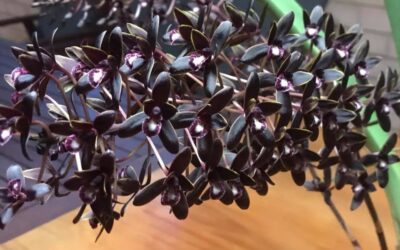Articles
ORCHID MOUNTS
Epiphytic orchids, those that live on trees, can easily adapt to growing on various types of mounting material. Many orchids do just fine growing in pots, but mounting orchids can allow them to grow healthier root systems and thrive for years longer than they...
Habenaria Orchids
Habenarias have been promoted as being among the most difficult orchids to grow. Yet if one pays particular attention to their general needs, they are actually one of the easiest. The most important key to their culture is watering. Asian species of Habenaria go...
FUNCTION OF THE MACRO AND MICRO NUTRIENTS
FUNCTION OF THE MACRO AND MICRO NUTRIENTS Nutrient Symbol Function Comments Boron (Borax or boric acid) B Involved in the movement of sugars, part of the cell membrane of growing roots and shoots, influences pollen health. Deficiency seen first in actively growing...
MICRO-CLIMATES IN YOUR ORCHID HOUSE
BASIC TIPS FOR RE-POTTING ORCHIDS
Don’t be afraid to re-pot your orchid. Despite their reputation, orchids are tough and re-potting helps them to thrive. When buying orchids, it is always wise to inspect the mix and the pot that the plant is in. Sometimes the mix is old and the pot does not suit the...
BULBOPHYLLUM ORCHID CARE
Bulbophyllum orchids, also known as “Bulbos,” are the largest genus of orchids with more than 2000 species. They are named after their bulbous leaves and are known for having an incredible range of flower shapes and colours. The bizarre species are considered to be...
WHY IS MY ORCHID NOT FLOWERING?
This is a list of 5 reasons why your orchid may not be flowering, we hope you find it informative. LIGHT LEVELS Overall, the most common reason that orchids fail to bloom is insufficient light. The Phalaenopsis and Paphiopedilum orchids are usually happy with the...
OVER WATERED AND UNDER WATERED ORCHIDS
Over-watered and under-watered orchids show many of the same symptoms because the effect of both practices is the same - damaged or destroyed root systems, which result in a dehydrated orchid. The signs of dehydration include the following: Pleated leaves; Excessively...
HOW TO IDENTIFY AND CONTROL COMMON PESTS
When you first notice pests on your orchids, you need to promptly and properly identify them so you can be sure to apply the most effective control. In many cases, especially if there are many pests present, you'll have to apply control measures every seven to ten...








